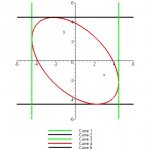Here's the problem:
"Consider the curve defined by y^2+xy+x^2=15.
a) Calculate dy/dx.
b) Show that at the two points where y=0, the tangent lines at those points are parallel.
c) Find the coordinates of all points at which there is a horizontal tangent line. Show your work."
For dy/dx, I got dy/dx= -(2x-y)/(2y+x). Is this correct?
Also, could someone show me how to do parts b) and c)?
"Consider the curve defined by y^2+xy+x^2=15.
a) Calculate dy/dx.
b) Show that at the two points where y=0, the tangent lines at those points are parallel.
c) Find the coordinates of all points at which there is a horizontal tangent line. Show your work."
For dy/dx, I got dy/dx= -(2x-y)/(2y+x). Is this correct?
Also, could someone show me how to do parts b) and c)?

